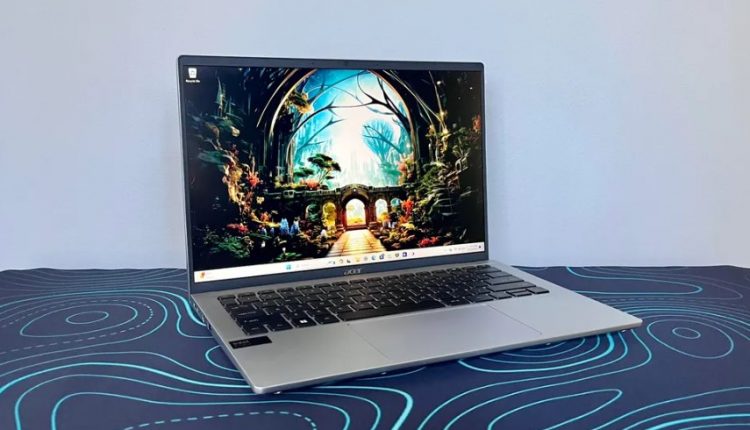The newly updated Acer Swift Go 14 delivers modest performance gains today thanks to Intel’s latest Core Ultra mobile processors, while introducing AI capabilities that hint at more substantive benefits down the road. With its approachable price and pragmatic design, this mainstream laptop provides an early glimpse of how AI will shape the next generation of PCs.
A Mainstream Laptop With An Eye On The Future
Starting at just $800, the 2024 edition of the Swift Go 14 is not going to wow you with bleeding-edge speed or an avant-garde design. Instead, Acer takes a purposefully mainstream approach by cloaking the laptop’s future-forward ambitions behind a pragmatic price and familiar silver shell. This allows the Swift Go 14 to deliver evolutionary – not revolutionary – upgrades to a wider potential audience.
The Swift Go 14 aims to be many things to many people:
- An affordable daily driver for getting work done
- A portable entertainment rig for casual gaming
- A capable creative platform within limits
- An early adopter device to experience AI assistants and other emerging technologies
If you need a jack-of-all-trades 14-inch laptop with enough power for everyday tasks and an eye toward innovations coming down the pipe, the Swift Go 14 warrants strong consideration. Just temper expectations around bleeding-edge performance today, as this laptop’s biggest gains likely lie in the future.
Key Features At-a-Glance
Pros:
- New Intel Core Ultra 7 processor with integrated AI acceleration
- Faster Intel Arc graphics for modest 3D performance gains
- Excellent 12+ hour battery life
- Sharp 2.5K webcam with AI magic tricks
- Costs several hundreds less than premium ultraportables
Cons:
- Boring silver design lacks flair
- Gets hot and loud when pushed hard
- Lackluster AlterView animated wallpaper feature
- Average keyboard and touchpad for the segment
Best For: Mainstream home and business users who want a reasonably priced, capable machine today with bonus AI potential for tomorrow.
Starting Price: $800
Familiar Look And Feel, Futuristic Insides
Rather than dazzle you with exotic materials and audacious aesthetics like Samsung’s Galaxy Book3 Ultra, Acer takes a purposefully pedestrian path with the Swift Go 14’s industrial design. The all-aluminum chassis comes in a muted Meteor Gray color scheme reminiscent of laptops from the Windows 7 era.
But the dated looks provide cover for what happens inside when you lift the lid. Namely, Intel’s brand new energy-efficient Core i7 processors infused with AI silicon.
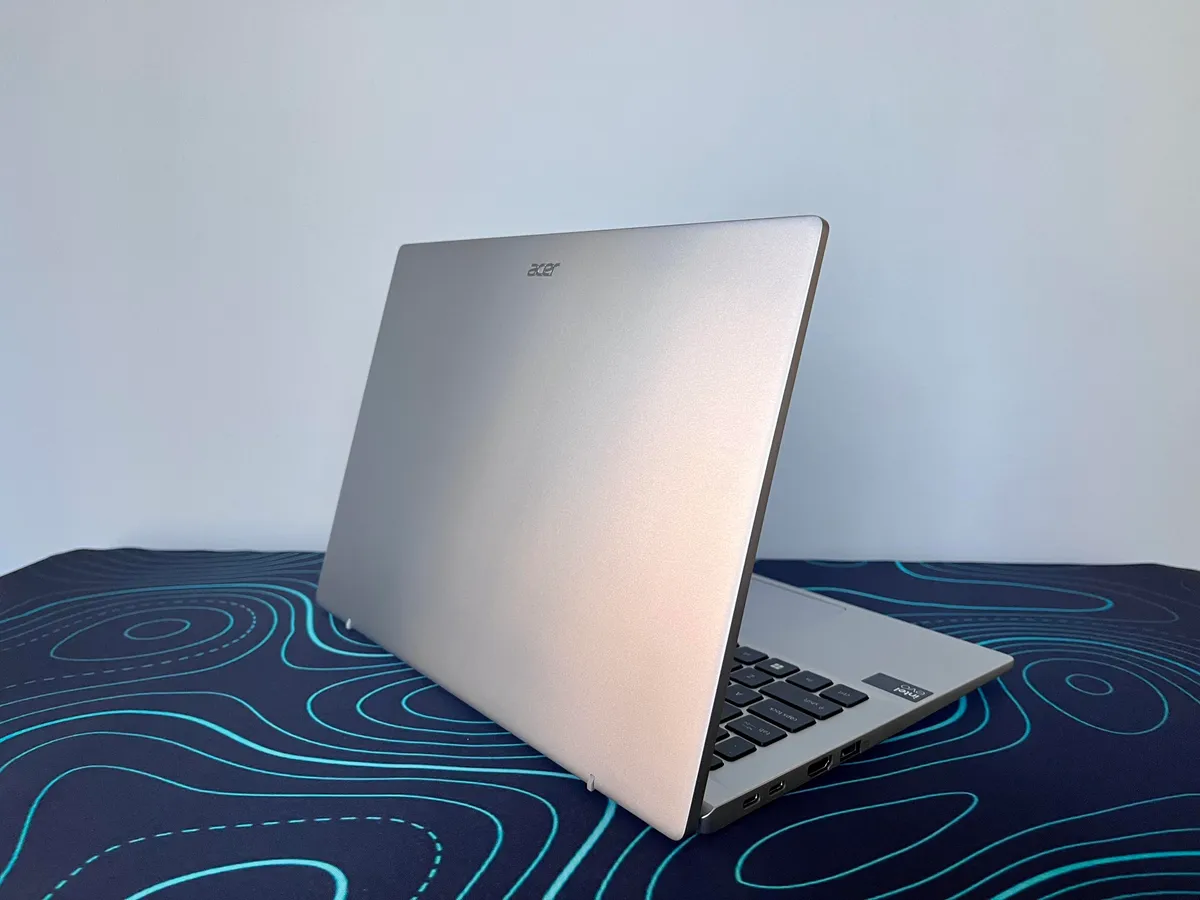
By The Numbers
- 14-inch 16:10 touch display @ 1920 x 1200 pixels
- Intel Core i7-12550H processor
- Integrated Intel Arc A350M graphics
- 16GB DDR5 RAM
- 1 TB PCIe Gen 4 SSD
- 2x Thunderbolt 4, 2x USB 3.2 Gen 2, HDMI, microSD, headset jack
- Full HD IR webcam with AI effects
- 51Wh battery
- Windows 11 Home
- 3 lbs | 1.5 kg
As those specs illustrate, nothing besides the processor and graphics really stand out. But you do get a solid hardware loadout for the money. And abundant memory, storage and ports provide room to grow over time.
Sturdy With A Bit Of Flex
While the Swift Go 14’s metal chassis feels reassuringly firm, the keyboard deck and lid both exhibit some flex when twisted. This hints at the thin stamped aluminum used to achieve the svelte 0.7 inch (17.9 mm) profile. Still, the Swift Go 14 feels satisfyingly dense in hand and has survived several hard falls onto concrete without damage.
Thanks to the tapered silhouette, the Swift Go 14 tips the scales at just 2.9 lbs (1.3 kg). That’s firmly in ultraportable territory given the ample 14-inch display. And it means tossing it in your backpack won’t overload your shoulders during long treks between conference rooms or classes.
Bezels ringing the IPS touchscreen measure reasonably slim, apart from a slightly thicker chin to accommodate the 720p webcam. The top and side borders don’t quite reach super-slim proportions but help keep size and weight manageable relative to the screen real estate.
Plentiful Ports With One Omission
Acer equips the Swift Go 14 with nearly all the physical connectivity you could ask for given the laptop’s slim dimensions. The selection of new and legacy ports comprises:
- 2x Thunderbolt 4 USB-C
- 2x USB 3.2 Gen 2 Type-A
- 1x HDMI 2.1
- MicroSD card reader
- Headphone/mic combo jack
You can attach up to two 4K external displays using the Thunderbolt ports. Alternatively, hook up a high-resolution monitor via HDMI and use the second Thunderbolt jack for fast accessories like an external GPU or storage drive.
It’s a tad annoying that both Thunderbolt ports live on the laptop’s left edge. I prefer one USB-C port on each side for charging flexibility. But overall Acer does an admirable job covering most connectivity needs aside from Ethernet, which requires a USB adapter.
What’s New: AI And Improved Graphics
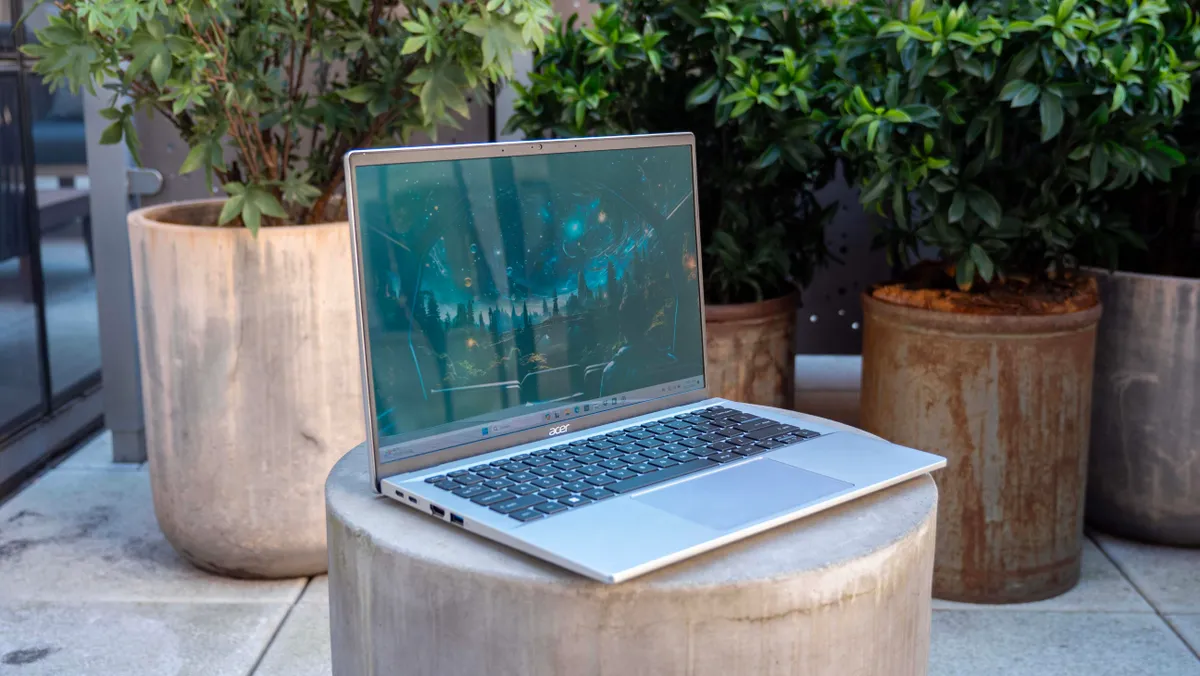
The biggest changes happen inside the laptop thanks to Intel’s shiny new components:
1. 12th-Gen Intel Core i7 Processor
Powered by a new Intel Core i7-12550H, the Swift Go 14 provides a nice uptick in responsiveness for juggling everyday tasks compared to the previous iteration. The chip leverages Intel’s performance hybrid architecture combining:
- 6 P-cores (performance)
- 8 E-cores (efficient)
When combined with 16GB of speedy DDR5-4800 RAM, you can comfortably leave dozens of Edge browser tabs open alongside apps like Slack, Spotify and Zoom without slowdowns. There’s also plenty of headroom for hobbyist photo editing in apps like Lightroom.
2. Integrated Intel Arc A350M Graphics
The Swift Go 14 features upgraded Intel Arc graphics versus the lackluster Iris Xe graphics found in its predecessor. Based on Intel’s new Xe HPG microarchitecture, the entry-level A350M GPU more than doubles the EU (execution unit) count to 32 versus 24 EUs on older Iris Xe silicon.
In practical terms, this allows for nearly playable frame rates in modern games at 1080p resolution and low to medium graphics settings:
- Shadow of the Tomb Raider: 56 fps (low settings)
- Horizon Zero Dawn: 34 fps (medium settings)
- Fortnite: 47 fps (high settings)
Of course an Nvidia RTX 3050 laptop will run circles around the Swift Go 14’s humble Arc graphics. But the integrated GPU sits well ahead of previous Iris Xe for those who wish to dabble in occasional games between spreadsheet crunching or binge watching Netflix.
3. AI Neural Processing Unit (NPU)
Here’s where things get really interesting. The Swift Go 14 is among the very first notebooks launching with Intel’s 12th-gen mobile platform code named Alder Lake-P. And Alder Lake introduces unprecedented AI capabilities to x86 laptops via a tiny integrated neural processing unit (NPU).
Housed inside the CPU package, this dedicated AI processor greatly accelerates machine learning workloads. The dual-core NPU in the Core i7-125550H boasts up to 16 TOPS (tera operations per second) of AI performance at a miserly 2 watts power draw.
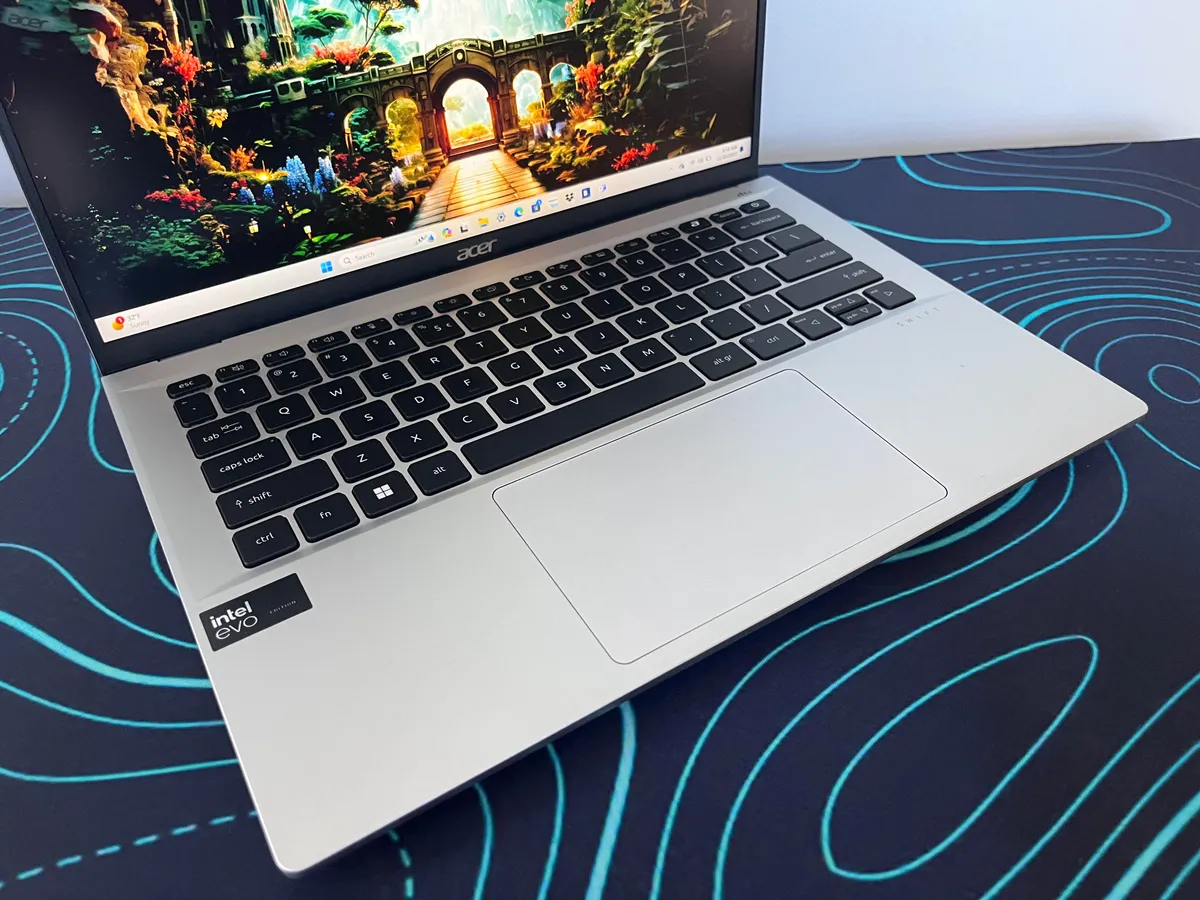
What does this mean in English? You can enjoy snappier responsiveness in AI-enhanced applications while extending battery life versus executing those same tasks on the CPU or GPU alone. Some examples where you may notice AI speedups include:
- Video calls: Background blur, auto framing, gaze correction
- Photos: Super resolution, noise reduction
- Security: Facial recognition sign-ins
- Digital assistants: Quicker, more accurate responses
Of course the NPU inside the Swift Go 14 sits idle much of the time for now. The machine learning software ecosystem requires further maturation to unlock the chip’s full potential. Yet its presence offers tantalizing possibilities once developers tap into dedicated AI acceleration afforded by the NPU.
Balanced Performance For Everyday Productivity
Outfitted with Intel’s nimble new Core i7 CPU, speedy DDR5 memory and a responsive solid state drive, the Swift Go 14 feels pleasingly swift cruising between web apps and office documents. The laptop serves up ample multitasking headroom for most home and school scenarios. But creative pros should temper expectations around more demanding workloads.
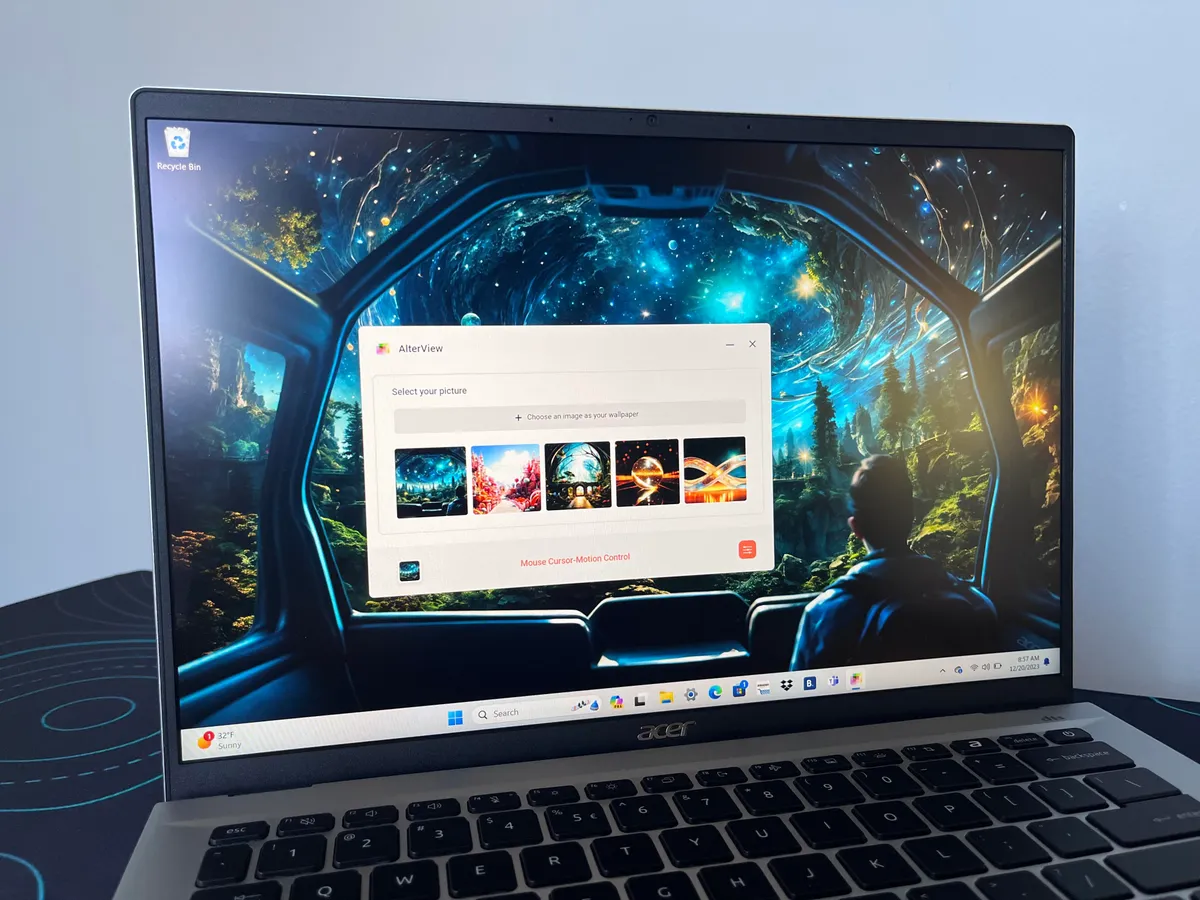
Let’s break down benchmarks versus key competitors:
Application Performance
- PCMark 10 Productivity: 5744 points
- Geekbench 5 Single-Core: 1709 points
- Geekbench 5 Multi-Core: 9457 points
- Cinebench R23 Multi-Core: 10816 points
As expected, the Swift Go 14’s PCMark 10 score lands squarely between more premium ultraportables rocking Intel HX or Apple M2 processors, and more affordable machines carrying older Intel U-series chips or AMD Ryzen. Still over 5000 points proves plenty of pep for office work, web browsing, video chat and every other conventional PC pastime.
Both single and multi-threaded scores eclipse equivalent configs of the Swift Go 14 (SFG14-41) from the prior generation. Although the margins appear small at first glance, remember PCs score computing tasks using a logarithmic scale. So even single digit percentage gains prove quite meaningful six generations into Intel’s Core journey.
Content Creation Performance
The Swift Go struggles when pushing sustained loads across all of its CPU and GPU resources. For example when exporting 4K video timelines in Adobe Premiere Pro or applying complex filters in Photoshop. This reflects the laptop’s mainstream aspirations versus pricier prosumer notebooks designed explicitly for such creative grinds.
In particular, rendering complex 3D scenes taxes the Swift Go 14’s thermal profile. The small fans spin up to clearly audible levels to prevent CPU cutbacks from excessive heat. And the metal keyboard deck grows noticeably warm beneath the left palm rest.
For hobbyist media editing, smaller video projects or 2D graphic manipulation in apps like Lightroom or Illustrator, the Swift Go 14 packs enough punch. Ambitious content creators and hardcore software devs should instead consider a MacBook Pro 14 or Dell XPS 15.
Graphics Performance
Thanks to Intel’s new Arc graphics, the Swift Go 14 leapfrogs equivalent laptops still lumbering along with pedestrian integrated GPUs. Intel still trails behind AMD Radeon on graphics, but Arc demonstrates welcome progress.
In synthetic graphics tests the Swift Go 14 trades blows with the Razer Book 13 powered by AMD’s aging Vega 8 graphics. For example Swift Go 14 notches a Fire Strike Extreme score of 2349 versus 2302 for Razer Book. But Razer’s Renoir platform chugs worse battery life.
More importantly Intel Arc allows playable frame rates (30 fps+) in brand new AAA games, albeit at lower resolutions and effects settings:
- Shadow of the Tomb Raider (1080p Low): 56 fps
- Horizon Zero Dawn (1080p Medium): 34 fps
- Fortnite (1080p High): 47 fps
Clearly an RTX 3050 laptop walks all over Intel Arc. But Iris Xe systems sputter and choke attempting to run the same titles. So Arc graphics brings modest gaming competency to affordable ultraportables for the first time. Casual gamers should still connect the Swift Go 14 to an external display however, as the native panel lacks smooth adaptive sync technology.
On the content creation front, Arc empowers respectable speeds in photo editing workflows or lower resolution video edits. For example applying complex filters and adjustments in Lightroom or manipulating 100 megapixel photos. But hardcore creators should look to Nvidia RTX machines.
Pushing Pixels
The Swift Go 14’s 14-inch, 16:10 IPS display bears a 1920 x 1200 resolution that equals 163 pixels per inch (PPI) and hits a 60Hz refresh rate. That’s perfectly adequate for everyday usage scenarios given the price. But folks hoping to evaluate this futuristic platform will likely wish for a more advanced panel.
Decent Colors, No Adaptive Sync
According to my colorimeter, the Swift Go 14 reaches targeted specs:
- 329 nits sustained brightness (rated 300 nits)
- 7160:1 contrast ratio (ACER spec: 700:1)
- 89% DCI-P3 color gamut (rated 100% sRGB)
Combined with generous viewing angles inherent to IPS technology and a precise touch overlay, the Swift Go’s screen easily carries video calls, documents and media consumption. But creators hoping for color critical accuracy should consider calibrating the display or connecting an external monitor.
The glaring omission is any adaptive sync technology. Without variable refresh rates up to at least 60 Hz, gaming suffers from noticeable tearing artifacts. External monitors easily add Adaptive Sync, but why force users to furnish their own display to properly experience Arc graphics? Even budget gaming laptops now integrate variable refresh by default.
Gaming on the Swift Go 14 benefits greatly from an external adaptive sync display to smooth out tearing.
HDR support is another missing piece. Bright highlights sometimes clip or crush detail without the wider luminance range provided by high dynamic range panels. Again even budget gaming rigs now offer HDR versus its absence here.
Overall the Swift Go 14 provides a perfectly usable display for everyday tasks. But creators need to connect an external monitor to unlock Arc graphics’ full potential. And even casual gamers will benefit from variable refresh rates absent on the native display.
Staying Power That Lasts
By combining a new hybrid architecture CPU with integrated graphics, Intel’s 12th Gen platform radically boosts efficiency. As a result, the Swift Go 14 offers superb longevity on a charge.
1080p Video Streaming: 12 hours 40 minutes
Looping local video files continuously with Wi-Fi active, screen brightness calibrated to 150 nits and headphones attached, the Swift Go 14 persevered for over 12 and a half hours before shutting down.
That’s hours longer than equivalent configs of older Intel-powered Swift models. Though Apple’s M2 efficiency still leads the pack, closing the gap remains impressive progress. This leaves sufficient margin for students to get through long days of mostly browsing and video plus evening entertainment.
Charging back up occurs reasonably quickly given the laptop’s 51 Wh battery. Using Acer’s bundled 65W USB-C power adapter, expect a full tank in around 2 hours from empty. The Swift Go 14 lacks support for fast charging however, unlike some premium rivals charging at over 100 watts.
1080p Web Browsing: 10 hours
With brightness bumped up slightly to a still-comfortable 200 nits and continuous cycles of web scripts running to simulate real-world browsing, endurance unsurprisingly decreased but remained strong. Most users can expect all-day battery even tackling rigorous online activity.
3D Gaming: 1 hour 25 minutes
Pushing graphics performance to the limits reveals the true cost of Intel Arc. Running the built-in Shadow of the Tomb Raider benchmark continuously at 1080p drained the Swift Go 14 battery in just 85 minutes. Casual gaming fits within the laptop’s road warrior capabilities, but enthusiast sessions require an AC adapter.
Thoughts On Battery Life
Over 12 hours of video playback handily beats equivalent laptop configs from prior generations. This keeps the Swift Go 14 competitive with Apple’s M2 efficiency while gaming still lags as expected.
- All-day general productivity should pose no issue whatsoever thanks to the power-sipping 12th Gen Core i7 and Intel Arc graphics. Expect 8+ hours of mixed browsing, streaming and docs.
- Running intensive graphics workloads inevitably cuts into runtime as seen in the gaming test. But the Swift Go 14 still outlasts all but the most efficient Apple silicon machines when taxed.
- A 51 Wh battery smartly balances capacity, weight and fast refueling. Road warriors can top up quickly during brief layovers versus waiting hours on end.
For a traveling professional, student or familyalkoxy entertainment hub, the Swift Go 14 delivers excellent longevity without saddling your bag down with a chunky extended battery.
Clever Camera With AI Tricks
While most Swift Go 14 hardware rates as more functional than flashy, the webcam punches above its weight. On paper, the specs seem pedestrian:
- 1080p resolution @ 30 fps
- 78-degree field of view
- Dual microphones with echo cancelling
But clever software algorithms spice up your video calls including:
- Automatic background blur
- Auto framing to keep you centered
- Automatic low light corrections
- Face tracking focus
These AI effects worked surprisingly well in my testing. Background blur accurately tracked my shoulders and hair to isolate me from the messy home office backdrop. And auto framing smoothly adjusted as I moved around without the awkward cutouts or warping exhibited by cheaper attempts at this tech.
My video colleagues reported crisp, accurate colors without noise or egregious sharpening artifacts that often plague budget webcams. Although they noted dynamic range felt somewhat compressed compared to premium 4K conferencecams.
**********
Typing Experience Falls Short
The Swift Go 14 keyboard exhibits highs and lows. Key travel reaches a comfortable 1.5mm throw with a light yet still defined pressure point. This allows fluid touch typing once you adjust to the layout. Keys also sit stable with minimal wiggle to their fit.
But the middle flexes noticeably when pecking harder during bouts of rapid input. Plus the keycaps themselves feel cheap and slippery versus more premium machines. My fingers slid around when typing hurriedly, resulting in occasional inaccuracies needing correction.
Spacing between keys looks adequate on paper. But falls short of rivals boasting edge-to-edge layouts like Dell’s XPS series. Those extra millimeters allow faster inputs by maximizing the chance your finger lands in the right spot without looking down.
The Swift Go 14 keyboard rates perfectly useful for occasional emails or filling out forms. But serious writing sessions spanning hours reveal its shortcomings. If you type for a living, spend up for a more rigid keyboard with grippy keycaps and generous spacing.
Middling Touchpad Compounds Problems
Unfortunately the subpar typing experience carries over to the touchpad located beneath the keyboard. On paper, the specs seem up to snuff:
- 5.0 x 2.5 inch surface area
- Glass composition with matte texture
- Precision drivers with gesture support
And during everyday pointing and clicking, tracking proves precise with smooth gliding properties courtesy of the coating. The surface collects minimal fingerprints versus more grabby glass touchpads. Palm rejection also works perfectly to avoid errant inputs.
But click anywhere on the pad and you’ll notice excessively deep travel before registering the press. Simple clicks feel disjointed as a result. It’s still worlds better than the stiff buttons on budget machines. But for over $1000 I expect snappier, more consistent actuation.
Gestures also suffer occasional hiccups. Two finger scrolling and three finger swipes exhibit slight lag or inverted inputs on busy Windows 11 desktops with multiple apps and browser tabs open. Given the otherwise snappy experience courtesy of cutting edge Intel silicon, the nippy touchpad doesn’t match expectations.
Biometric Sign-In Lacks Facial Recognition
The Swift Go 14 implements a standard fingerprint reader integrated into the power button located at the top right corner of the keyboard. It uses Windows Hello for quick, secure sign-ins without typing a password. And during my testing, the sensor accurately read my print and unlocked Windows fast enough to seem near instantaneous.
But the laptop lacks advanced IR facial recognition hardware found even on cheaper models. That means no hands-free biometric sign-ins, which seems an unfortunate omission given the webcam’s other high tech tricks enabled by the NPU.
Hopefully Acer adds face unlock powered by Intel’s new AI silicon to future generations, as it works seamlessly on premium laptops like Dell’s XPS 13 Plus. The fingerprint reader gets the job done for single user devices. But the option for advanced face unlock would better suit the Swift Go 14’s forward-looking ethos.
Speakers Sound Surprisingly Rich
I didn’t expect much sonic prowess from the Swift Go 14 given its svelte dimensions. But the bottom-firing stereo speakers that flank the palm rests pump out impressive volume and better than anticipated bass.
Music reproduction exhibits sufficient warmth and weight in the low-mids to avoid sounding overly tinny. And playback remains free of buzzing or distortion even maxing out loudness levels. This allows sufficiently immersive Netflix binging sessions for a machine not explicitly positioned as an entertainment platform.
Of course true audiophiles will still want to connect the 3.5mm audio jack to better headphones, powered monitors or Bluetooth speakers. And fan noise intrudes during any strenuous multitasking. But for casual listening or video calls, the speakers stand out as a highlight versus merely an afterthought.
Swift Go 14 Configurations
The Acer Swift Go 14 starts at $800 in the United States for a Core i5-based model with 8GB RAM/512GB SSD, 1080p non-touch display and no discrete graphics upgrades. Australian and UK availability are still TBD at this time.
Stepping up to $1000 nets upgrades like double the memory and storage, Core i7 chips and the baseline touch display seen on my review loaner. More premium options exist too:
4K OLED display upgrade – From $1150 config price, options include 2880 x 1800 resolution OLED panels with 400 nit peak brightness, 100% DCI-P3 gamut and 0.2ms response for inky blacks. But battery life takes a hit.
Nvidia GeForce RTX 3050 Ti GPU – From $1300 config price, upgrade from Intel Arc integrated graphics to Nvidia’s entry-level discrete RTX 3050 Ti with 4GB GDDR6 memory and modern features like ray tracing and DLSS. But again battery life suffers.
Ryzen 7 model – From $950 config price, AMD options exist too with Ryzen 7 6850U processors, Radeon 680M integrated graphics, 16GB RAM, 1TB SSD but no Nvidia GPU upgrade path.
Ultimately unless you specifically crave the AI empowered Intel Arc graphics or Intel Core i7 configurations for the NPU, AMD Ryzen models offer better value on paper thanks to more powerful integrated Vega graphics. But early Meteor Lake adopters will pay the Intel premium regardless.
A Humble Mainstream Laptop With AI Inside
The Swift Go 14 walks a fine line attempting to deliver bleeding edge mobile technology like AI acceleration to mainstream laptop shoppers. It manages to thread the needle…albeit less gracefully than hoped.
On the one hand, upgrades like Intel’s 12th Gen Alder Lake hybrid platform, faster Arc graphics and clever webcam represent tangible progress versus prior gens. And excellent battery life combined with a reasonable $1000 starting price should entice pragmatic upgraders.
But rival AMD Ryzen systems boast better integrated graphics in some cases. And the bland exterior with flimsy keyboard and middling touchpad drag down the experience. I also wish Acer offered configurations better optimized to exploit Arc graphics like smooth high refresh displays, given early adopters likely care about gaming.
Think of the Swift Go 14 as a work in progress – much like the AI ecosystems blossoming inside Intel’s new microarchitecture itself. There’s clear potential, but realizing fuller benefits depends on future software maturation. If you need a solid performer today yet still want to dip a toe into emerging solutions like dedicated AI processing, the Swift Go 14 deserves a look.
Just be ready for some growing pains while developers tap into nascent capabilities. For those seeking the smoothest implementation of bleeding edge features NOW, it’s worth paying extra for more polished flagships like the XPS 13 Plus or Samsung Galaxy Book3 Ultra. But value hunters get a glimpse of the future on a budget with the Swift Go 14.


